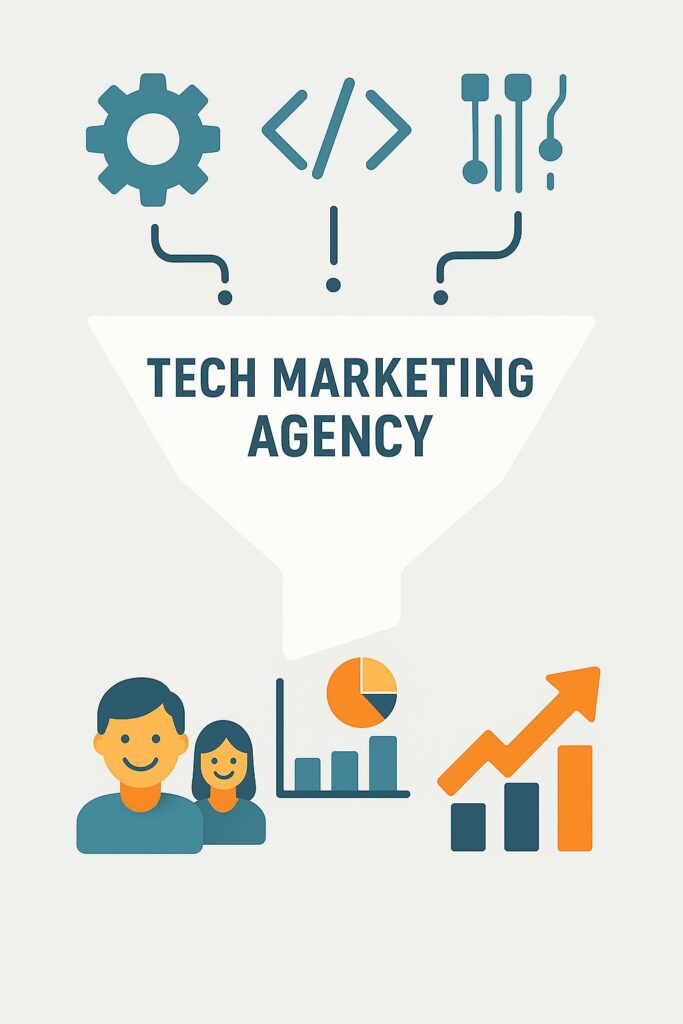Tech marketing agencies help technology companies translate complex products into clear value that buyers understand.
The best teams connect positioning with pipeline, and they do it with a repeatable playbook that spans strategy, content, and paid media.
This guide explains what these agencies do, how they differ from general shops, and how to pick the right partner for specific goals. It keeps things practical, so you can apply it to your plan.
What Tech Marketing Agencies Do
Tech marketing agencies help turn complex technical features into business benefits that customers understand.
They make sure your product’s key selling points reach the right audience, run campaigns and set up ways to track results.
Digital Strategy and Planning
Tech marketing agencies start by defining the ideal customer profile (ICP): for example, SaaS firms with a specific tech stack or security need.
They map who’s involved in the buying process and what triggers a purchase, such as funding rounds, compliance deadlines, or integration issues.
Planning links marketing with product and revenue ops. The team defines what counts as qualified demand, and decides when to move leads from product-led flows to sales follow-up.
The strategy phase includes:
- Positioning that connects product features to business value.
- Channel mix across search, review platforms, and partner ecosystems.
- Experiments to test new offers, messaging, or onboarding paths.
Content Marketing
In tech, content has to prove credibility fast. Buyers are technical, skeptical, and short on time.
Good agencies turn real product knowledge into material that answers customers’ questions: how it works, how it integrates, what problems it actually solves.
They start by talking to subject matter experts, engineers, and sales teams. Insights from those calls turn into assets like:
- API guides
- Migration walkthroughs
- Security explainers
- Performance benchmarks
Blog posts bring in search traffic; deeper content (like implementation guides or ROI breakdowns) helps sales teams close deals.
Strong content also improves paid performance. When landing pages match intent and explain value clearly, conversion rates rise and acquisition costs drop.
Performance Marketing and Paid Campaigns
Agencies manage paid search, LinkedIn and X ads, review platforms, retargeting, and content syndication.
Creative and messaging tests happen constantly.
Budgets shift toward the tactics driving qualified leads, and reporting tracks full-funnel metrics, not just clicks.
- Top of funnel: market education, category terms, and comparison guides.
- Mid funnel: webinars, benchmark reports, and feature tours.
- Bottom of funnel: competitor alternatives, pricing explainers, and free trials.
Channel planning should respect audience context and B2B constraints. LinkedIn often plays a role for targeting professionals and companies, and its ad platform gives useful levers for B2B reach.
How Tech Marketing Agencies Differ from General Ones
General agencies do branding, creative, and broad campaigns.
Tech-specialist teams go deeper on product, buyers, and funnels that run through CRM and revenue operations.
- They plan around long cycles and complex buying committees. B2B purchases often involve many stakeholders with different priorities. That complexity requires channel depth and rigorous qualification.
- They map ideal customer profiles and use methods like firmographic market segmentation to reach the right accounts, not just large audiences.
- They treat security, compliance, and integrations as messaging pillars, because those topics shape trust in technical categories.
Quick comparison:
| Factor | General Agency | Tech Marketing Agency |
|---|---|---|
| Buyer Complexity | Broad consumer or simple B2B | Multi-role buying groups, procurement, InfoSec |
| Sales Cycle | Short to mid | Mid to long |
| Core Metrics | Impressions, clicks | Pipeline, SQLs, CAC, payback |
| Skills | Creative, brand, basic digital | Product marketing, RevOps, ABM, technical SEO |
| Content | General thought leadership | Technical guides, case studies, integration stories |
Key Qualities to Look For
Technical Understanding of Your Product or Industry
Agencies serving tech should be comfortable with docs, SDKs, and integrations.
They translate features into outcomes, and they know the pains of admins, engineers, or analysts who will evaluate the product.
Signals to look for:
- Ability to explain the product in simple terms without losing precision.
- Knowledge of common security frameworks and procurement checklists.
- Case studies that deal with data migrations, APIs, and change management.
Data-Driven Approach and Relevant Channel Experience
Data is the language of growth.
A good partner sets up tracking, cleans UTM conventions, and builds dashboards tied to revenue. They choose the right model for your stage.
Multi-touch helps in longer cycles, while rules-based attribution can be fine early on.
Implementation skills count:
- Proper analytics setup in tools like Google Analytics 4.
- CRM alignment and naming standards that match your funnel stages.
- Comfort with experimentation and statistical rigor.
Transparent Reporting and Measurable Outcomes
Weekly reports should show what happened, why it happened, and what changes next. Numbers must map to business impact, not just channel metrics.
Core key performance indicators (KPIs) to expect:
- Pipeline and sales-qualified lead (SQL) volume by segment.
- Customer acquisition cost (CAC), payback, and lifetime value (LTV) signals.
- Conversion rates across key steps: visitor to lead, lead to marketing-qualified lead (MQL), MQL to SQL.
If your team defines marketing qualified leads differently from sales, align terms early.
How to Evaluate Tech Marketing Agencies
Evaluation should be structured. Use a short scoring rubric and compare agencies on the same factors.
Reviewing Case Studies and Portfolios
Case studies should show context, constraints, and results tied to revenue. Look for:
- A clear ICP and problem statement.
- Measurable outcomes tied to pipeline, not just traffic.
- A short list of experiments, including the ones that failed and what was learned.
It helps when examples cover your motion, such as B2B SaaS marketing for mid-market, or enterprise account-based motions.
Checking Client References and Alignment With Business Goals
Ask about responsiveness, candor during tough weeks, and how the team handled misses.
A short approach:
- Share goals and constraints in writing. Be specific about targets and resources.
- Ask the reference if the agency pushed back when needed. Respectful challenge is a good sign.
- Confirm they can collaborate with sales and RevOps, not just run isolated campaigns.
Consistency is more important than perfection. An agency that learns fast and communicates clearly will create more value over a quarter than an erratic genius.
Assessing Team Expertise
You are hiring a team, not a pitch deck. Request the actual roster and review:
- Product marketing skill for positioning and messaging.
- Channel specialists for search, social, and partnerships.
- Analytics and RevOps for tracking and data quality.
- Project management that keeps work moving with predictable cadence.
Ask for examples of technical writing and creative. Portfolios should include landing pages, case studies, and ads that match your tone and audience.
Cost Considerations
Pricing depends on scope, speed, and seniority.
Pricing Models and Value Assessment
Common models include retainers, projects, and performance components. Each has tradeoffs.
| Model | When It Fits | Pros | Cons |
|---|---|---|---|
| Retainer | Ongoing programs | Predictable budget, steady velocity | Requires clear backlog and governance |
| Project-based | Fixed scope, tight timeline | Defined deliverables, easy to compare bids | Less flexibility if priorities change |
| Performance or hybrid | Specific outcomes with clear measurement | Incentives align to results | Needs clean data and fair attribution rules |
Value shows up as faster time to learning, lower CAC, cleaner CRM data, and better sales enablement. Review cost against revenue impact, not just hours.
Avoiding Hidden Fees
Nobody likes unpleasant surprises. Be explicit about:
- Ad platform fees and credit card processing.
- Software costs for SEO, analytics, or account-based marketing (ABM) tools.
- Media management fees and markups.
- Change requests, rush work, and creative revisions.
Ask for a rate card and a sample invoice. A good agency will walk through the details and explain what is included.
Questions to Ask Before Hiring
Better questions lead to better fit. Use these to stress-test alignment.
Approach to Tech Product Marketing
Start with ICP and the problem your product solves. Then go deeper.
Questions worth asking:
- How do you translate complex features into simple outcomes for buyers?
- What is your plan for demand capture vs demand creation in the first 90 days?
- How do you support sales with enablement and objection handling?
- What is your ABM approach for key accounts, and how do you prioritize tiers?
If you want to see how they think, request a short workshop or a written mini-brief. You can compare approaches against your own framework or a published go-to-market strategy example.
Tools and Methods for Measuring Return on Investment (ROI)
Measurement should be agreed upon before campaigns launch. Align on:
- Primary outcomes like pipeline and SQLs, with source of truth set in the CRM.
- Secondary signals like assisted conversions and brand search.
Implementation basics include analytics configuration, event tracking, and clean attribution. Review the GA4 setup steps in the official Google Analytics 4 documentation and confirm who owns data quality.
Summary
- Tech marketing agencies understand complex products, long sales cycles, and multi-stakeholder buying. They speak product and revenue.
- Strong partners align around measurable outcomes. Pipeline, SQLs, CAC, and LTV outrank vanity metrics.
- Smart selection starts with fit. Ask about ICP clarity, channel experience, and the team that will work on your account.
- Pricing varies by model and scope. Value shows up in faster learning, lower waste, and predictable growth.
- Demand generation needs content, performance media, and sales alignment working as one system.
Marketing agencies earn their keep by translating complex value into steady revenue outcomes. Stryng is one of them; reach out to their team or try their AI content marketing platform for free.
Frequently Asked Questions
Q: What kinds of companies get the most value from a tech marketing agency?
A: Teams with limited in-house capacity or specialized needs see strong returns. Complex products, long cycles, or regulated industries benefit from deep expertise.
Q: How long until results show up?
A: Expect early learning in weeks, then stronger signals within one to three quarters. Time varies by offer, budget, and sales cycle length.
Q: Is an agency better than hiring in-house?
A: It depends on goals and timeline. Agencies bring a full stack of skills and faster execution. In-house teams offer tighter day‑to‑day control and product proximity.
Q: What metrics matter most for B2B SaaS marketing?
A: Pipeline, SQLs, CAC, payback period, and LTV carry the most weight. Channel metrics help diagnose issues but should not drive decisions alone.
Q: Where does account-based marketing fit in a plan?
A: ABM works best for higher deal sizes and defined target lists. Use it to deepen relevance, while demand generation programs keep the broader funnel healthy.
Q: What makes a case study credible?
A: Clear context, buyer pain, and measurable outcomes tied to revenue. Screenshots and quotes help, but the story must show cause and effect.



